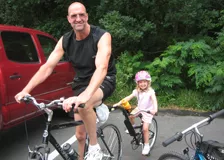
Arthur Caputi, 52, knew he faced daunting odds. The Grounds Supervisor at Northeastern University was living with a ”silent killer” known as an Abdominal Aortic Aneurysm (AAA). AAA, a condition in which bulges develop in the walls of the aorta, the body’s largest artery, often leads to rupture and death if left untreated. But the father of three from Fitchburg is also a fighter, who was determined to optimize his quality of life.
“It’s all about finding the right medical team,” says Caputi.
All in the family
Further complicating his medical outlook, Caputi had inherited Marfan syndrome - a rare genetic disorder affecting connective tissue - from his father who had died from the combination of this genetic mutation and AAA. So Caputi was vigilant about getting routine scans to check for aneurysms. He was enjoying good health until a vacation on Cape Cod in 2002, when he went down a water slide, and the resulting pressure in his chest caused “excruciating pain.” At the local hospital, Caputi insisted that he receive a CT scan; he says his stubbornness saved his life.
Caputi was rushed by ambulance to Tufts Medical Center, where he remained in the ICU for 11 days to get his blood pressure under control. He was discharged with the highest advisable dose of hypertension medication, but a month later, he was back at Tufts MC an emergency open heart surgery was performed. The aneurysm repair was successful. With a second “new lease on life,” Caputi was discharged after six days in the hospital and quickly returned to work. However, he was advised he had another aneurysm that needed to be monitored.
For the next 15 years, Caputi was extremely mindful of his health. He received frequent blood pressure checks and underwent tests at Tufts MC to monitor the aneurysm’s growth. All was well until November 2017, when Tufts MC physicians found that his aneurysm had grown to 6 cm, the point at which surgery is typically recommended. However, the surgical risks were much greater this time. Caputi’s aneurysm had descended into his abdomen and leg artery, requiring a highly complex procedure necessitating the reopening of the scar tissue from the original incision.
Second opinion, third life-saving event
Caputi wanted to pursue an aggressive course, knowing that his aneurysm could rupture at any time. After initial medical consultation revealed hesitancy about open heart surgery, Caputi met with his surgical team and together they decided to move ahead. The resulting 22-hour procedure saved Caputi’s life for a third time.
After a month’s stay in the hospital and three weeks of rehab, Caputi began five months of slow but steady recovery at home.
One of Caputi’s surgeons, Payam Salehi, MD, PhD, has continued to monitor his progress, and the last checkup showed excellent results. Today, Caputi is pain-free and has resumed his normal life.
“Typically, we perform minimally invasive procedures for aneuryms, but every patient is unique, and we need to customize treatment plans,” says Dr. Salehi. “Arthur is one of 200,000 Americans diagnosed with AAA every year, but he is part of only 2 percent of the population with Marfan’s syndrome. Patients like Arthur inspire me.”
“There’s no substitute for having the most experienced physicians, but patients also need to know their bodies and advocate for themselves,” says Caputi. “Thanks to Tufts Medical Center and my persistence, I’m on my bike again and working out. I want to be here for my wife and kids, including my youngest daughter, who also has Marfan’s syndrome.”